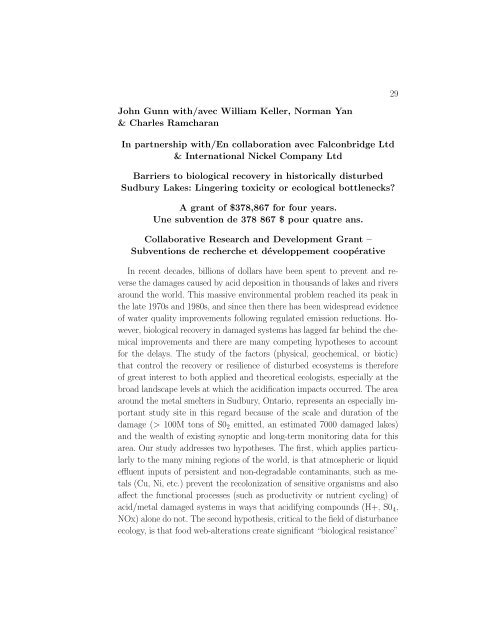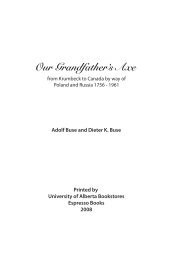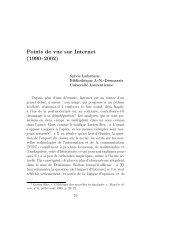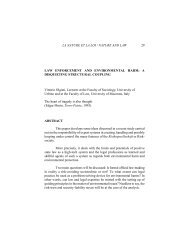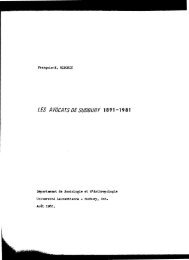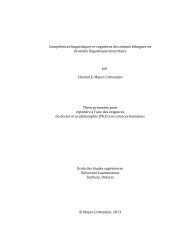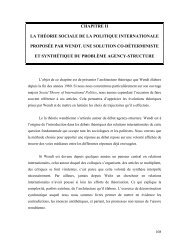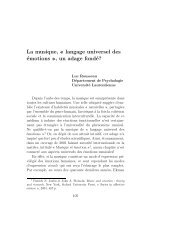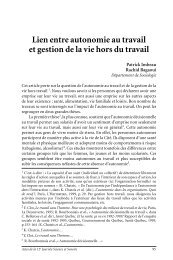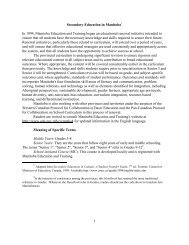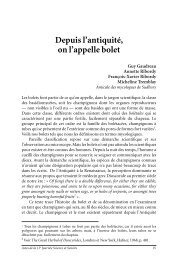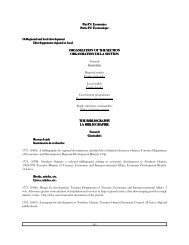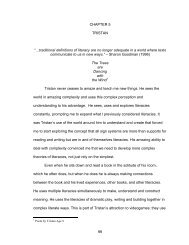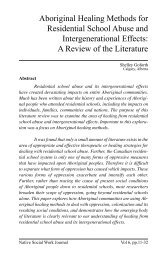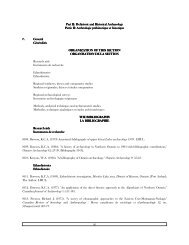NSERC grants at Laurentian University Subventions du CRSNG `a l ...
NSERC grants at Laurentian University Subventions du CRSNG `a l ...
NSERC grants at Laurentian University Subventions du CRSNG `a l ...
- No tags were found...
Create successful ePaper yourself
Turn your PDF publications into a flip-book with our unique Google optimized e-Paper software.
29John Gunn with/avec William Keller, Norman Yan& Charles RamcharanIn partnership with/En collabor<strong>at</strong>ion avec Falconbridge Ltd& Intern<strong>at</strong>ional Nickel Company LtdBarriers to biological recovery in historically disturbedSudbury Lakes: Lingering toxicity or ecological bottlenecks?A grant of $378,867 for four years.Une subvention de 378 867 $ pour qu<strong>at</strong>re ans.Collabor<strong>at</strong>ive Research and Development Grant –<strong>Subventions</strong> de recherche et développement coopér<strong>at</strong>iveIn recent decades, billions of dollars have been spent to prevent and reversethe damages caused by acid deposition in thousands of lakes and riversaround the world. This massive environmental problem reached its peak inthe l<strong>at</strong>e 1970s and 1980s, and since then there has been widespread evidenceof w<strong>at</strong>er quality improvements following regul<strong>at</strong>ed emission re<strong>du</strong>ctions. However,biological recovery in damaged systems has lagged far behind the chemicalimprovements and there are many competing hypotheses to accountfor the delays. The study of the factors (physical, geochemical, or biotic)th<strong>at</strong> control the recovery or resilience of disturbed ecosystems is thereforeof gre<strong>at</strong> interest to both applied and theoretical ecologists, especially <strong>at</strong> thebroad landscape levels <strong>at</strong> which the acidific<strong>at</strong>ion impacts occurred. The areaaround the metal smelters in Sudbury, Ontario, represents an especially importantstudy site in this regard because of the scale and <strong>du</strong>r<strong>at</strong>ion of thedamage (> 100M tons of S0 2 emitted, an estim<strong>at</strong>ed 7000 damaged lakes)and the wealth of existing synoptic and long-term monitoring d<strong>at</strong>a for thisarea. Our study addresses two hypotheses. The first, which applies particularlyto the many mining regions of the world, is th<strong>at</strong> <strong>at</strong>mospheric or liquideffluent inputs of persistent and non-degradable contaminants, such as metals(Cu, Ni, etc.) prevent the recoloniz<strong>at</strong>ion of sensitive organisms and alsoaffect the functional processes (such as pro<strong>du</strong>ctivity or nutrient cycling) ofacid/metal damaged systems in ways th<strong>at</strong> acidifying compounds (H+, S0 4 ,NOx) alone do not. The second hypothesis, critical to the field of disturbanceecology, is th<strong>at</strong> food web-alter<strong>at</strong>ions cre<strong>at</strong>e significant “biological resistance”


